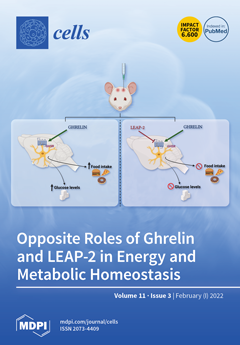High mobility group box 2 (HMGB2) is a non-histone chromosomal protein involved in various biological processes, including cellular senescence. However, its role in cellular senescence has not been evaluated extensively. To determine the regulatory role and mechanism of HMGB2 in cellular senescence, we
[...] Read more.
High mobility group box 2 (HMGB2) is a non-histone chromosomal protein involved in various biological processes, including cellular senescence. However, its role in cellular senescence has not been evaluated extensively. To determine the regulatory role and mechanism of HMGB2 in cellular senescence, we performed gene expression analysis, senescence staining, and tube formation assays using young and senescent microvascular endothelial cells (MVECs) after small RNA treatment or
HMGB2 overexpression.
HMGB2 expression decreased with age and was regulated at the transcriptional level. siRNA-mediated downregulation inhibited cell proliferation and accelerated cellular senescence. In contrast, ectopic overexpression delayed senescence and maintained relatively higher tube-forming activity. To determine the
HMGB2 downregulation mechanism, we screened miRNAs that were significantly upregulated in senescent MVECs and selected HMGB2-targeting miRNAs. Six miRNAs, miR-23a-3p, 23b-3p, -181a-5p, -181b-5p, -221-3p, and -222-3p, were overexpressed in senescent MVECs. Ectopic introduction of miR-23a-3p, -23b-3p, -181a-5p, -181b-5p, and -221-3p, with the exception of miR-222-3p, led to the downregulation of
HMGB2, upregulation of senescence-associated markers, and decreased tube formation activity. Inhibition of miR-23a-3p, -181a-5p, -181b-5p, and -221-3p delayed cellular senescence. Restoration of
HMGB2 expression using miRNA inhibitors represents a potential strategy to overcome the detrimental effects of cellular senescence in endothelial cells.
Full article






